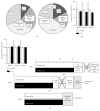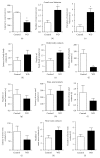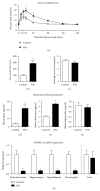Autism-Like Behaviours and Memory Deficits Result from a Western Diet in Mice
- PMID: 28685102
- PMCID: PMC5480052
- DOI: 10.1155/2017/9498247
Autism-Like Behaviours and Memory Deficits Result from a Western Diet in Mice
Abstract
Nonalcoholic fatty liver disease, induced by a Western diet (WD), evokes central and peripheral inflammation that is accompanied by altered emotionality. These changes can be associated with abnormalities in social behaviour, hippocampus-dependent cognitive functions, and metabolism. Female C57BL/6J mice were fed with a regular chow or with a WD containing 0.2% of cholesterol and 21% of saturated fat for three weeks. WD-treated mice exhibited increased social avoidance, crawl-over and digging behaviours, decreased body-body contacts, and hyperlocomotion. The WD-fed group also displayed deficits in hippocampal-dependent performance such as contextual memory in a fear conditioning and pellet displacement paradigms. A reduction in glucose tolerance and elevated levels of serum cholesterol and leptin were also associated with the WD. The peroxisome proliferator-activated receptor gamma coactivator 1-alpha (PPARGC1a) mRNA, a marker of mitochondrial activity, was decreased in the prefrontal cortex, hippocampus, hypothalamus, and dorsal raphe, suggesting suppressed brain mitochondrial functions, but not in the liver. This is the first report to show that a WD can profoundly suppress social interactions and induce dominant-like behaviours in naïve adult mice. The spectrum of behaviours that were found to be induced are reminiscent of symptoms associated with autism, and, if paralleled in humans, suggest that a WD might exacerbate autism spectrum disorder.
Figures






Similar articles
-
Prefrontal cortex inflammation and liver pathologies accompany cognitive and motor deficits following Western diet consumption in non-obese female mice.Life Sci. 2020 Jan 15;241:117163. doi: 10.1016/j.lfs.2019.117163. Epub 2019 Dec 13. Life Sci. 2020. PMID: 31837337
-
Metabolic, Molecular, and Behavioral Effects of Western Diet in Serotonin Transporter-Deficient Mice: Rescue by Heterozygosity?Front Neurosci. 2020 Feb 18;14:24. doi: 10.3389/fnins.2020.00024. eCollection 2020. Front Neurosci. 2020. PMID: 32132889 Free PMC article.
-
Moderate physical activity promotes basal hepatic autophagy in diet-induced obese mice.Appl Physiol Nutr Metab. 2017 Feb;42(2):148-156. doi: 10.1139/apnm-2016-0280. Epub 2016 Oct 12. Appl Physiol Nutr Metab. 2017. PMID: 28084795
-
Diet-induced obesity progressively alters cognition, anxiety-like behavior and lipopolysaccharide-induced depressive-like behavior: focus on brain indoleamine 2,3-dioxygenase activation.Brain Behav Immun. 2014 Oct;41:10-21. doi: 10.1016/j.bbi.2014.03.012. Epub 2014 Mar 27. Brain Behav Immun. 2014. PMID: 24681251
-
SERT-Deficient Mice Fed Western Diet Reveal Altered Metabolic and Pro-Inflammatory Responses of the Liver: A Link to Abnormal Behaviors.Front Biosci (Landmark Ed). 2025 Jan 21;30(1):26778. doi: 10.31083/FBL26778. Front Biosci (Landmark Ed). 2025. PMID: 39862090
Cited by
-
Resilience and Vulnerability to Stress-Induced Anhedonia: Unveiling Brain Gene Expression and Mitochondrial Dynamics in a Mouse Chronic Stress Depression Model.Biomolecules. 2023 Dec 12;13(12):1782. doi: 10.3390/biom13121782. Biomolecules. 2023. PMID: 38136653 Free PMC article.
-
Anxiety, Depression, and the Microbiome: A Role for Gut Peptides.Neurotherapeutics. 2018 Jan;15(1):36-59. doi: 10.1007/s13311-017-0585-0. Neurotherapeutics. 2018. PMID: 29134359 Free PMC article. Review.
-
Sex-Specific ADHD-like Behaviour, Altered Metabolic Functions, and Altered EEG Activity in Sialyltransferase ST3GAL5-Deficient Mice.Biomolecules. 2021 Nov 24;11(12):1759. doi: 10.3390/biom11121759. Biomolecules. 2021. PMID: 34944404 Free PMC article.
-
Molecular signature of excessive female aggression: study of stressed mice with genetic inactivation of neuronal serotonin synthesis.J Neural Transm (Vienna). 2023 Sep;130(9):1113-1132. doi: 10.1007/s00702-023-02677-8. Epub 2023 Aug 5. J Neural Transm (Vienna). 2023. PMID: 37542675 Free PMC article.
-
ASD-like behaviors, a dysregulated inflammatory response and decreased expression of PLP1 characterize mice deficient for sialyltransferase ST3GAL5.Brain Behav Immun Health. 2021 Jul 27;16:100306. doi: 10.1016/j.bbih.2021.100306. eCollection 2021 Oct. Brain Behav Immun Health. 2021. PMID: 34589798 Free PMC article.
References
MeSH terms
Substances
LinkOut - more resources
Full Text Sources
Other Literature Sources
Medical

